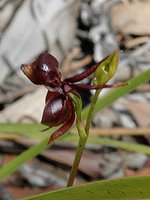 Today I led a National Parks Association walk "with a difference" - an Orchid Ramble.
Today I led a National Parks Association walk "with a difference" - an Orchid Ramble.While the numbers were not great, we did have some enthusiasts who travelled to the Southern Highlands to join us. We had a lady from Sydney and a guy from Wollongong. There was a couple from Moss Vale, and 4 people from Robertson and one from Carrington Falls. Anyway, those of us who did turn up had a lovely time.
 We started in the tall forest along Kirkland Road, and we found lots of Flying Duck Orchids (in a very restricted area, where obviously the conditions are "just right" for this species). In the same area, we found two species of Bearded Orchids (similar plants, but with subtle differences, in the way the petals are held wide open on one species, and half-closed over on the other).
We started in the tall forest along Kirkland Road, and we found lots of Flying Duck Orchids (in a very restricted area, where obviously the conditions are "just right" for this species). In the same area, we found two species of Bearded Orchids (similar plants, but with subtle differences, in the way the petals are held wide open on one species, and half-closed over on the other). In the same area, we also found a white flowered Caladenia (White "Ladies Fingers" Orchid).
In the same area, we also found a white flowered Caladenia (White "Ladies Fingers" Orchid). Then we moved into an area where there were many stunning blue "Sun Orchids", of two different species. (Only one species shown here.)
Then we moved into an area where there were many stunning blue "Sun Orchids", of two different species. (Only one species shown here.)Then we moved out onto Tourist Road, and immediately we were into Tiger Orchids, more Sun Orchids (though with less intense colours, but seemingly the same species, with the same basic structures inside the flower, perhaps just different because they were growing in poorer soils.
 |
| Prasophyllum appendiculatum (Amended ID, by Dr Mark Clements) |
On 7 March 2012, I received advice that his plant has now been formally identified as Prasophyllum appendiculatum.
 We then found many more of the Bearded Orchids, of two species. This photo is of the Purplish Beard Orchid (Calochilus robertsonii) - the species which stays less "open" than the other species.
We then found many more of the Bearded Orchids, of two species. This photo is of the Purplish Beard Orchid (Calochilus robertsonii) - the species which stays less "open" than the other species.Along the way, we also noted many plants of the Proteacaea family. At one stage, I asked the group to each stand beside a particular plant. We had Woody Pear, Persoonia (3 species), Banksia (one species), Waratah, Lomatia (2 species), and a Petrophile. All these nine related plants, all members of the Proteacaea, were growing side by side, within a circle of 15 metres. Not bad biodiversity that. Later on, in the same are, I was able to add a Grevillea, and another Persoonia, , and another Banksia.
When we went to the Tourist Road, I was able to show the group 5 different species of Persoonia growing within a 10 metres circle. There was also a prostrate Persoonia growing about 200 metres away. These species were P. linearis, P. levis, P. glaucescens (an endangered species - the "Mittagong Geebung"), P. myrtilloides (not previously recorded in this district), and P. mollis. The prostrate species is P. oxycoccoides. Furthermore, in this area, we added another Grevillea, a Hakea, a Conospermum, and an Isopogon to the previous list of Proteacaea plants (bringing that related group of plants to 18 species on our walk).
Along the way, we saw many wonderful wildflowers, especially the lovely purple Native Irises (Pattersonia sp), and literally thousands of the Sowerbae (Vanilla Rush-lily), numerous different low growing Pea flowers, Trigger Plants, "Yellow Candles" and the showy pinkish-purple "Match heads".
 At the very end of the walk, I was able to show the group a single plant of the miniature fern the Forked Comb Fern. A nice little "find" - an uncommon plant, just 4 inches high, growing amongst some dry grass.
At the very end of the walk, I was able to show the group a single plant of the miniature fern the Forked Comb Fern. A nice little "find" - an uncommon plant, just 4 inches high, growing amongst some dry grass.This photo shows a single frond, which always seems to remain closed, unlike the more familiar ferns, such as Tree Ferns and Bracken Ferns, which have a flattened frond. This has the same structure, it just does not open out flat. This photo shows the fern at about twice life size (even before clicking to show the photo at maximum resolution).

2 comments:
The white-flowered Caladenia is absolutely gorgeous, I don't think I have seen that one before - so I am rather sorry I missed the walk. Too many things to do last week.
And I see you got a nice pic of the bearded orchid this time!
Hi Anni
Yes, it was a lovely little plant, but not so showy in the bush (it is tiny). You need to get down on your hands and knees, with a magnifying glass, to see it well. But as a large sized "Macro" image it is stunning.
The purple lip shows up well, and inside, there is a pattern of tiny nodules, and a set of "ridges" on either side, which apparently guide insects to the point where they need to go, in order to find the nectar, or scent. They act for tiny insects, just as "aircraft landing lights" on an airport runway, apparently.
I would be happy to take you out Orchid spotting later in the week, or on the weekend, if the weather warms up (the Orchids like warm weather).
Denis
Post a Comment